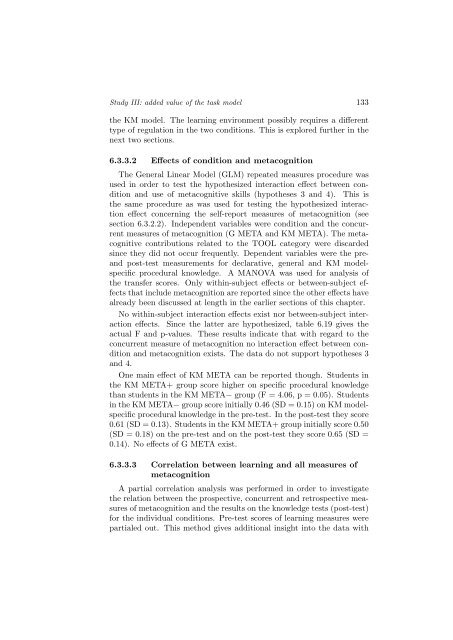The role of metacognitive skills in learning to solve problems
The role of metacognitive skills in learning to solve problems
The role of metacognitive skills in learning to solve problems
Create successful ePaper yourself
Turn your PDF publications into a flip-book with our unique Google optimized e-Paper software.
Study III: added value <strong>of</strong> the task model 133<br />
the KM model. <strong>The</strong> learn<strong>in</strong>g environment possibly requires a different<br />
type <strong>of</strong> regulation <strong>in</strong> the two conditions. This is explored further <strong>in</strong> the<br />
next two sections.<br />
6.3.3.2 Effects <strong>of</strong> condition and metacognition<br />
<strong>The</strong> General L<strong>in</strong>ear Model (GLM) repeated measures procedure was<br />
used <strong>in</strong> order <strong>to</strong> test the hypothesized <strong>in</strong>teraction effect between condition<br />
and use <strong>of</strong> <strong>metacognitive</strong> <strong>skills</strong> (hypotheses 3 and 4). This is<br />
the same procedure as was used for test<strong>in</strong>g the hypothesized <strong>in</strong>teraction<br />
effect concern<strong>in</strong>g the self-report measures <strong>of</strong> metacognition (see<br />
section 6.3.2.2). Independent variables were condition and the concurrent<br />
measures <strong>of</strong> metacognition (G META and KM META). <strong>The</strong> <strong>metacognitive</strong><br />
contributions related <strong>to</strong> the TOOL category were discarded<br />
s<strong>in</strong>ce they did not occur frequently. Dependent variables were the preand<br />
post-test measurements for declarative, general and KM modelspecific<br />
procedural knowledge. A MANOVA was used for analysis <strong>of</strong><br />
the transfer scores. Only with<strong>in</strong>-subject effects or between-subject effects<br />
that <strong>in</strong>clude metacognition are reported s<strong>in</strong>ce the other effects have<br />
already been discussed at length <strong>in</strong> the earlier sections <strong>of</strong> this chapter.<br />
No with<strong>in</strong>-subject <strong>in</strong>teraction effects exist nor between-subject <strong>in</strong>teraction<br />
effects. S<strong>in</strong>ce the latter are hypothesized, table 6.19 gives the<br />
actual F and p-values. <strong>The</strong>se results <strong>in</strong>dicate that with regard <strong>to</strong> the<br />
concurrent measure <strong>of</strong> metacognition no <strong>in</strong>teraction effect between condition<br />
and metacognition exists. <strong>The</strong> data do not support hypotheses 3<br />
and 4.<br />
One ma<strong>in</strong> effect <strong>of</strong> KM META can be reported though. Students <strong>in</strong><br />
the KM META+ group score higher on specific procedural knowledge<br />
than students <strong>in</strong> the KM META− group (F = 4.06, p = 0.05). Students<br />
<strong>in</strong> the KM META− group score <strong>in</strong>itially 0.46 (SD = 0.15) on KM modelspecific<br />
procedural knowledge <strong>in</strong> the pre-test. In the post-test they score<br />
0.61 (SD = 0.13). Students <strong>in</strong> the KM META+ group <strong>in</strong>itially score 0.50<br />
(SD = 0.18) on the pre-test and on the post-test they score 0.65 (SD =<br />
0.14). No effects <strong>of</strong> G META exist.<br />
6.3.3.3 Correlation between learn<strong>in</strong>g and all measures <strong>of</strong><br />
metacognition<br />
A partial correlation analysis was performed <strong>in</strong> order <strong>to</strong> <strong>in</strong>vestigate<br />
the relation between the prospective, concurrent and retrospective measures<br />
<strong>of</strong> metacognition and the results on the knowledge tests (post-test)<br />
for the <strong>in</strong>dividual conditions. Pre-test scores <strong>of</strong> learn<strong>in</strong>g measures were<br />
partialed out. This method gives additional <strong>in</strong>sight <strong>in</strong><strong>to</strong> the data with
















